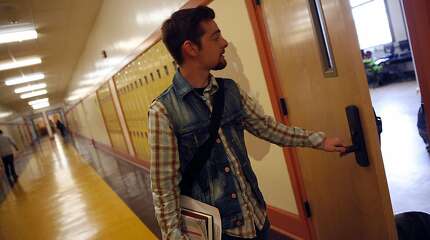April 13, 2013
They were sad tears, not happy tears.
But if Mission High were a book, it would have an awful cover that offers little insight to what's inside.
And it is a cautionary tale, students said, of how statistics and test scores don't always tell the whole story of a school.
Faynleyb, now 18, had to choose from 10 universities that accepted him.
He's decided to attend UC Berkeley and will have plenty of company from the other 29 Mission High classmates accepted to Cal for the fall - nearly 15 percent of the school's class of 2013.
That's more than double the 13 students accepted to Cal last year and quadruple the seven in 2011.
Nearly 90 percent of the class has been accepted to at least one college or university and the vast majority will go, school officials said.

Lea Suzuki, The Chronicle
Aleksandr Faynleyb will attend UC Berkeley, one of 10 schools accepting him.
Like many of the Mission students, Faynleyb "completely" attributes his long list of college choices to his time at Mission.
"I feel like there has always been a stigma against Mission," he said. "If I didn't go to this school, I wouldn't have had half the opportunities I've had."
Behind the scores
So why the low test scores?
Nearly half the 900 students are English learners, many new to the United States with little to no fluency in the language, and about 70 percent are low income, both of which typically align with low test scores.
In addition, 18 percent of the students are in special education programs, significantly higher than the average 10 or 11 percent at most schools in the state.

Lea Suzuki, The Chronicle
Alexandra Edwards, 18, teases a visiting photographer as Principal Eric Guthertz shows off his Mission High School tattoo.
None of that shows up in statewide school rankings, where Mission has historically landed in the bottom 10 to 20 percent of California schools.
Michelle Li wasn't sure what to expect when she got to Mission as a lonely freshman in 2009. All her middle-school friends had gone to the "good" schools: Lowell, Washington, Lincoln.
They felt sorry for her, she said.
Now they envy her and her long list of college acceptances, including Cal.
"I had all these opportunities they didn't have," she said.
Pushing achievement
Last summer, 171 Mission students went to summer academic or athletic programs at university campuses across the country, paid for by the nonprofit Athletic Scholars Advancement Program, which is embedded at the high school and serves about half the students.
The program serves students involved in sports, but that could be as a player, team manager or even the students who write about sports for the newspaper.
Students spend hours and hours in the program office, working with 25 trained volunteers to research colleges, write personal statements, get recommendations, apply for financial aid and scholarships and decide where to go. In between, the volunteers help students get internships, participate in clubs and community service, and keep their grades up.
"We work really intensely with students," said Liz Butler Steyer, the program's executive director. "It's more like the counseling you get at private schools."
The program frees up school staff to work more closely with other students.
In addition to college and academic counselors who guide students, every teacher works with a handful of students to develop college plans, Guthertz said.
"It's all hands on deck," he said. "We're bugging the kids constantly."
All the hard work appears to have impressed college admissions officers, including those at Cal.
"At UC Berkeley, our holistic review process looks at the academic rigor within the context of what the school offers and academic success through grades and scores," said university spokeswoman Janet Gilmore, "but also participation in the community and activities that show leadership, commitment and a love of learning."
One girl's turnaround
When Janira Odar, 17, transferred to Mission after a year at Washington High, she had none of what Cal or other colleges were looking for. D's filled her report card.
Mission teachers pushed her to retake freshman classes to boost her grades.
She will graduate this spring with a 4.0 grade point average and a list of colleges to choose from, including UC Berkeley.
These kinds of success stories are starting to overpower the test scores in the realm of public opinion, Guthertz said.
Mission expects to have a waiting list for ninth-grade spots by the time school starts in the fall.
"I think the neighborhood is hearing this," the principal said. "What I hear from families is that they're really clamoring to get in here."